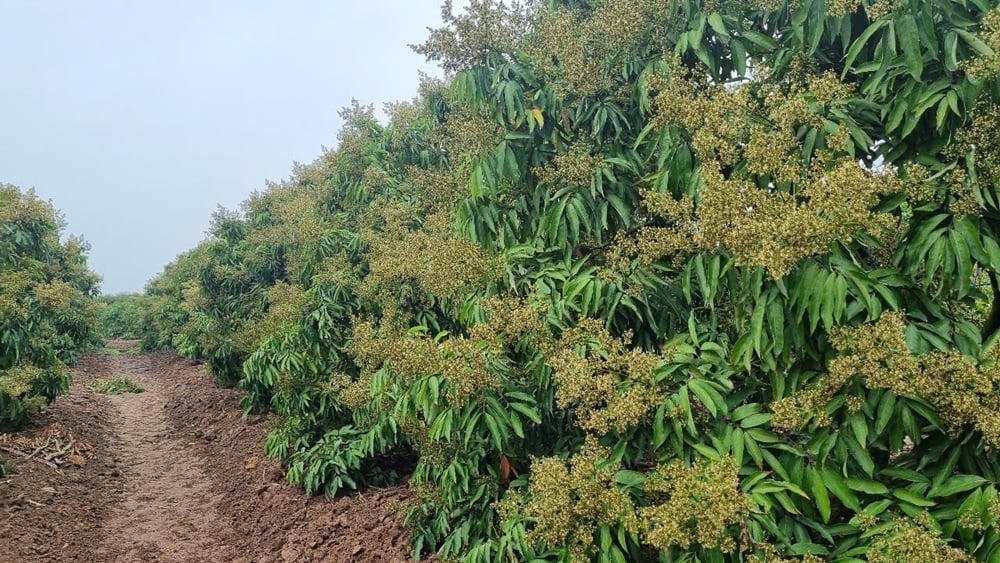April 5, 2025 | 12:08 GMT +7
April 5, 2025 | 12:08 GMT +7
Hotline: 0913.378.918
April 5, 2025 | 12:08 GMT +7
Hotline: 0913.378.918
Ten cold air incursions have affected Vietnam since the beginning of the year, with three episodes of severe and extreme cold, as per the Hydrometeorological Agency's statistics. This figure is equivalent to that of 2024. Unseasonal rains have arrived early in the Central Highlands and Southern regions, despite the fact that extensive rainfall has not yet occurred.
The first three months of 2025 have seen specific effects on agricultural production as a result of weather developments. The growth of winter-spring commodities, particularly rice and vegetables, has been severely affected by severe cold spells in the North. Frost and ice significantly affected certain mountainous regions, resulting in decreased crop yields. At the same time, the Central and Central Highlands regions have experienced higher-than-average rainfall in certain areas, which has contributed to the enhancement of irrigation water resources and the establishment of favorable agricultural conditions. However, provinces such as Nghe An, Ha Tinh, and Kon Tum, which experience rainfall that is substantially below the long-term average (LTA), are currently experiencing localized drought risks. These risks are affecting long-term industrial crops and winter-spring crops.

In Hai Duong, favorable weather conditions have resulted in over 95% of lychee and longan trees blooming. Photo: Trung Nguyen.
In February, the South experienced unseasonal rainfall, which mitigated drought conditions and extended the irrigation season for winter-spring rice, citrus trees, and vegetables. Therefore, this year's dry season has been relatively mild, with minimal instances of extreme temperatures. But three saline intrusion events have presented coastal areas with difficulties in obtaining fresh water for irrigation, as the salinity boundaries have exceeded the LTA. In certain rice and fruit-growing regions situated 45–50 km from the coast, saltwater infiltrated canal systems, necessitating that farmers implement measures to reserve fresh water in order to safeguard their crops.
International meteorological agencies have predicted that 2025 may be one of the hottest years ever documented on a global scale. The National Center for Hydro-Meteorological Forecasting anticipates that the temperature in Vietnam will remain elevated, with the possibility of a few brief, intense heatwaves. However, it is not anticipated that these heatwaves will surpass the records for temperature or duration established in 2024.
The maximum anticipated temperatures for the summer of 2025 in Northern Vietnam are 38–41°C, while those in Central Vietnam are 39–42°C. The Central Highlands are expected to experience temperatures between 36–39°C, while Southern Vietnam is expected to experience temperatures between 36–39°C.
For the first time, the Ministry of Agriculture and Environment officially announced water resource scenarios for key river basins in its decisions.
The Hydrometeorological Authority confirms that the water resource scenarios announced by the Ministry of Agriculture and Environment at the end of 2024 for these river basins are still valid for reference, as evidenced by the actual hydrometeorological developments in the first three months of the year and current forecasting models. It is anticipated that the rainfall patterns and trends in the forthcoming months will not deviate significantly from those depicted in the previously published scenarios.
It is anticipated that saltwater intrusion in the Mekong River will progressively decrease in the Southern region beginning in mid-May, and it is unlikely to have a substantial impact on agricultural production. The Southeastern region's coastal areas are expected to experience approximately eight tidal surges from April to December 2025, with the highest tides occurring between October and December, according to long-term forecasts.
The highest flood level in the upstream Mekong River is anticipated to reach approximately flood warning level 1 in 2025. The peak levels at downstream stations are anticipated to range from level 2 to level 3, with some areas potentially exceeding level 3. The water conditions in the Mekong Delta during the dry season of 2025–2026 are anticipated to be comparable to those of the 2024–2025 dry season.

Saltwater intrusion in the South will gradually decrease from mid-May and have little impact on agricultural production. Photo: Trung Nguyen.
The Hydrometeorological Authority is collaborating with the Department of Water Resources Management to advise and promptly update stakeholders in the event of any significant deviations from the published scenarios, as well as closely monitoring actual developments and updating forecasting models.
According to Mr. Mai Van Khiem, Director of the National Center for Hydro-Meteorological Forecasting (under the Hydrometeorological Authority), the current and remaining months of 2025's observed data and forecasts indicate that, in general, large-scale hydrometeorological conditions are consistent with agricultural production timelines. The current guidance on crop structure and planting schedules is in accordance with the anticipated weather and climate conditions. In general, the weather conditions for the forthcoming production seasons this year are regarded as favorable.
Nevertheless, it is imperative to closely monitor regional and sub-regional variations due to the inherently unpredictable nature of weather patterns. If not addressed in a timely manner, such localized anomalies could lead to specific losses at the local level. Therefore, local authorities are advised to actively follow short-term meteorological forecasts and updates to implement proactive response measures.
Translated by Linh Linh

(VAN) Economic experts Le Xuân Nghia and Le Dang Doanh analyze the impact of Donald Trump's reciprocal tariff on the Vietnamese economy.

(VAN) Military Bank (MB), in collaboration with the Vietnamese Navy, has officially launched the HiGreen 'Truong Sa' program, aiming to plant one million trees across Truong Sa (Spratly) Islands in Khanh Hoa province.

(VAN) The two Asiatic black bears were surrendered by locals from Muong Nhe District (Dien Bien) and transferred to Hoang Lien National Park for care and management.

(VAN) Interview with Vincent Martin, Director of the FAO Office of Innovation.

(VAN) Hon Cau marine protected area is home to many rare marine species, including coral, fish, and seabed animals.

(VAN) VIETNAM EXPO 2025 allows Vietnamese and international businesses to join hands in cooperation, optimizing high-tech solutions across multiple sectors.